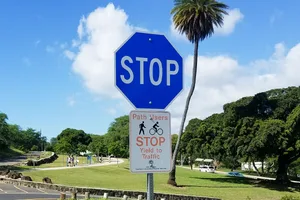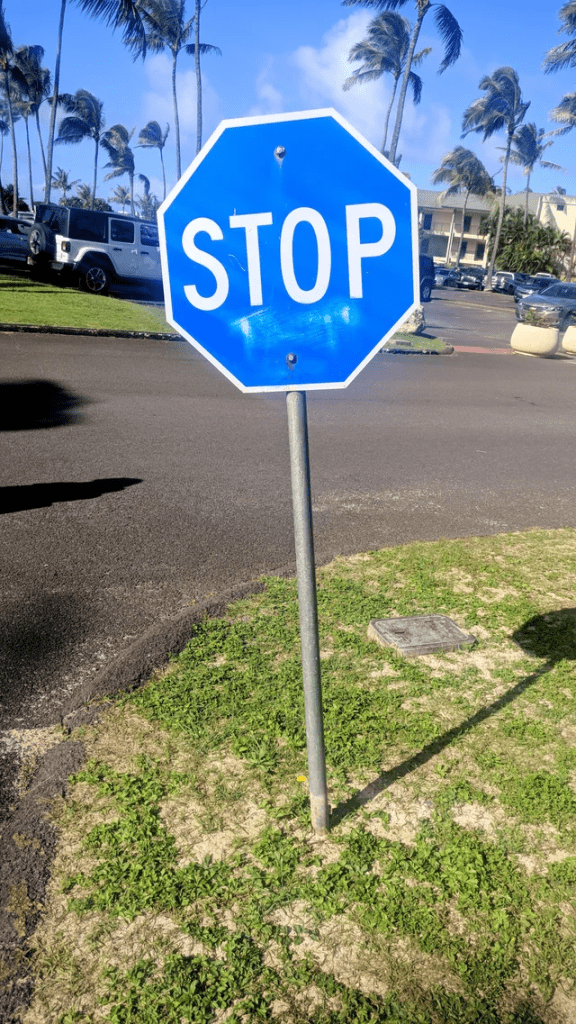We all recognize the classic red stop sign—it’s a universal symbol that tells drivers to halt before proceeding. But what happens when you come across a blue stop sign? If you’ve ever spotted one, you might have wondered if it has a different meaning or if it’s even an official traffic sign.
Surprisingly, blue stop signs do exist, though they are not part of the standard U.S. roadway system. They have a unique purpose and are mostly found in specific locations, private properties, and international roadways. Let’s dive into what these unusual stop signs mean, where you might see them, and how they differ from their traditional red counterparts.

What Does a Blue Stop Sign Mean?
A blue stop sign still means stop, just like the red one. However, these signs are not issued by state or federal authorities and are not considered official traffic control devices.
Since 1954, the Federal Highway Administration (FHWA) has mandated that all stop signs in the U.S. be red. The choice of red was intentional—it’s a highly visible color, associated with warnings and commands, making it the best option for ensuring road safety.
So, why do blue stop signs exist? They are mainly used in non-public spaces such as:
- Private properties (golf courses, resorts, or gated communities)
- Private roads (large estates, ranches, or business complexes)
- International roadways (countries like Japan and South Korea use blue signs differently)
While a blue stop sign does not hold legal authority on public roads, it still serves the same function—it tells drivers to stop.
Where Are Blue Stop Signs Found?
1. Blue Stop Signs on Private Property
In the U.S., you won’t find blue stop signs on public roads, but they are common on private land. Property owners use them to enforce traffic rules within their estates or businesses.
One state where blue stop signs are more noticeable is Hawaii. Hawaii’s traffic laws prohibit official stop signs on private property, so many businesses and resorts use blue stop signs instead. These signs do not violate state law, but they still help regulate vehicle movement in parking lots, private roads, and gated communities.
2. Blue Stop Signs in Other Countries
While the United Nations established the red octagonal stop sign as an international standard in 1968, some countries still use blue stop signs in different ways.
- Japan & South Korea → In these countries, blue stop signs typically indicate restricted access or no-entry zones. They do not mean “stop and proceed” like the red stop signs in the U.S. Instead, they tell drivers that they cannot continue past that point.
- Mexico → Some areas in Mexico use blue stop signs, but they are still less common than the traditional red ones.
- Other parts of Asia & Europe → Some private road systems use blue stop signs for internal navigation, though they are not legally enforceable on public roads.
3. The Difference Between Blue and Red Stop Signs
The main difference between a blue and red stop sign is legality and authority:
- Red stop signs → Legally enforceable on public roads under U.S. traffic laws and international regulations.
- Blue stop signs → Used mainly on private property and do not carry official legal enforcement on public roadways.

Can You Install a Blue Stop Sign on Your Property?
If you own a large property with internal roads, you can install a blue stop sign to regulate traffic. Many businesses, apartment complexes, and private roads use them to direct vehicles.
However, there are some restrictions:
- You cannot place a blue stop sign on a public roadway. Only state or local governments can authorize stop signs on public streets.
- Blue stop signs have no legal enforcement on public roads. If someone ignores a blue stop sign, they likely won’t be ticketed by law enforcement.
That said, drivers should still respect blue stop signs, as they are there for safety reasons. If you see one, it’s a good idea to stop and proceed with caution.
Why Are Standard Stop Signs Always Red?
Ever wondered why red was chosen for stop signs? It’s not just about visibility—it’s about psychology and science.
- Red grabs attention → It’s the most noticeable color for the human eye, especially in low-light conditions.
- Red signals urgency → Studies show that red is associated with danger, warnings, and stopping, making it the perfect choice for traffic control.
- International consistency → In 1954, the U.S. officially standardized red stop signs, and in 1968, the United Nations adopted the red octagonal sign globally. This consistency helps ensure that drivers from different countries instantly recognize stop signs.
Final Thoughts: What Should You Do If You See a Blue Stop Sign?
While a blue stop sign isn’t legally enforceable on public roads, it still carries the same message—stop and proceed with caution. These signs are mainly found on private property, resorts, and international roads, where they help regulate traffic in non-public spaces.
If you ever see a blue stop sign, respect it just as you would a red one—it’s there to keep drivers and pedestrians safe. Even though it may not be officially recognized by the government, it still serves an important function.
So, next time you come across a blue stop sign, you’ll know exactly what it means and where it belongs. Keep an eye out, drive safely, and stay informed!